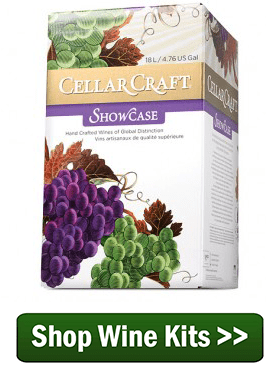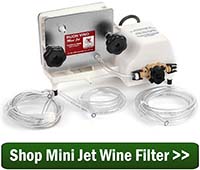 I have a sister who has a serious bronchial reaction to drinking wine made with sulfite. I have a neighbor who’s making wine without sulfites to kill the yeast at the end. He simply waits until it dies of starvation. My sister has no reaction to his wine. I have discovered that boiling the must before starting the yeast without using sulfite is sufficient to start the process. Now I would like to find a method of killing the yeast when I want to stop the process. I thought perhaps I could use a high temperature to kill the yeast at the end, but I don’t know how high that temperature would have to be. Can you help me?
I have a sister who has a serious bronchial reaction to drinking wine made with sulfite. I have a neighbor who’s making wine without sulfites to kill the yeast at the end. He simply waits until it dies of starvation. My sister has no reaction to his wine. I have discovered that boiling the must before starting the yeast without using sulfite is sufficient to start the process. Now I would like to find a method of killing the yeast when I want to stop the process. I thought perhaps I could use a high temperature to kill the yeast at the end, but I don’t know how high that temperature would have to be. Can you help me?
Name: Frits D.
State: Arkansas
—–
Hello Frits,
There seems to be a little bit of confusion. The reason that sulfites are added to any wine after the fermentation is to keep the wine from spoiling – to keep it fresh – not stop a fermentation. A fermentation should run its course until the sugars are all gone, starvation as you say. Sulfites can slow a domesticated wine yeast, but it can not consistently stop it completely, and therefor is not dependable for this purpose.
With that being said, making wine without sulfites is simple. The hard part is keeping the wine from degrading or spoiling after it has been made.
To start off the fermentation, I do not recommend boiling the juice or wine must. When you heat a juice you are promoting oxidation. This can cause the wine to turn color, usually orange or brown. It can also affect the wine’s flavor by adding a caramel to raisin note to it.
The one time I think you should add sulfites is before the fermentation — even if you are making wine without sulfites. Any free sulfite that is in the wine at this point will be long gone by the time the fermentation has completed. The sulfite will readily dissipate as a gas. Why not take advantage of that fact?
This applies to making wine from fresh fruits and juices. If you are making wine from a juice concentrate, then no treatment or sulfite is required at all. For this reason, you may want to consider taking this avenue. Currently, we have over 200 different juice concentrates to choose from.
As for keeping the wine from spoiling after the fermentation, one solution is to always keep the wine refrigerated. It’s simple and effective. The bad part is you need to dedicate most, or all, of a refrigerator to this method. This is one reason why hardly anyone is making wine without sulfites.
A second option that will significantly reduce the risk of spoilage is filtering the wine with ultra-fine filtration. This mean filtering down to 0.5 microns. This is a lot finer than letting the wine drip through a coffee filter. That would only be 20 to 25 microns. Filtering down to 0.5 microns requires the use of an actual wine filter, one that can force the wine under pressure through extremely fine pads. You are literally filtering out over 99% of the wine yeast along with mold spores and bacteria.
The Mini Jet wine filter would be the way to go for this purpose. It is important to realize that before using any wine filter, the wine should be finished dropping out sediment, naturally. It should look visually clear before filtering.
 Also, keep in mind that you will want to be vigilant towards keeping the winemaking area sanitary. All the equipment and anything else that comes into contact with the wine needs to be as clean and sterile as possible. There are a whole host of cleansers and sanitizers you can use to do this safely. This is a critical part to making wine without sulfites.
Also, keep in mind that you will want to be vigilant towards keeping the winemaking area sanitary. All the equipment and anything else that comes into contact with the wine needs to be as clean and sterile as possible. There are a whole host of cleansers and sanitizers you can use to do this safely. This is a critical part to making wine without sulfites.
As a final note, there is no such thing as making a wine without any sulfites at all. In part, because sulfite is actually produced during the fermentation. It’s a natural byproduct of the fermentation. The best you can do is to keep the sulfites to a level low. You can expect to see a fermentation produce a wine with 10 to 15 PPM (parts-per-million). When adding sulfites as normally directed the wine will end up with 50 to 75 PPM.
As you can see, making wine wine without sulfites can be easily done. It’s the extra care that needs to be taken to keep the wine fresh and free from spoilage that makes it difficult. But, if you are willing to be sanitary, filter the wine and/or store the wine under refrigeration… it can be done!
I hope this information helps you out.
Happy Winemaking,
Ed Kraus
—–
Ed Kraus is a 3rd generation home brewer/winemaker and has been an owner of E. C. Kraus since 1999. He has been helping individuals make better wine and beer for over 25 years.

This information was very helpful and reassuring. We have been making sulfite free (or low sulfite, if you prefer) wine for 7 years now. I use sulfite at crush time to kill off the wild yeast; then add my own yeast the following day. Once fermentation is complete, everything is kept as sterile as possible. We use vodka to sterilize anything that comes in contact with the wine. Also, we use only Organicide on our vines to prevent mildew and insect damage. We prune and thin to get yearly yields of about 350 gallons (Cabernet, merlot, and Chardonnay). We have not had a bad batch of wine yet; but we keep our wine at a constant 55-60 degrees, and usually consume it within 2 years.
Do you know of wine that can be purchased using your method?
Organic wine is made without added sulfites. If you buy organic wine, you can be sure that it contains no added sulfites. Wine “made with organic grapes” however may be produced with methods similar to regular wine, so check the labels carefully.
Ed,
What research, if any, are you aware of killing yeast by freezing and what effect would it have on flavor and longevity of the wine?
I ask because I like a semi-sweet wine (5 brix or 1.012 SG) and had a bottle explode in storage 30 years ago when I first started making wine (Nobody was around and I managed to safely decork the rest of the batch). Because of that I have made high alcohol wines since aiming for the alcohol threshold of the yeast adding sugar sparingly so I don’t get stuck with over sweet wine.
Most of my wine is drank as a nightcap for health reasons but on occasion I’d like to share a few glasses with company without inebriation being a factor. If there is a way to take part of a batch (I generally make 12-13 gal. batches) before the alcohol gets too high and cold treat it then sweeten it before aging without fear of explosion I’d try it.
I thought of using a yeast with a lower alcohol tolerance but then I’m going to have a completely different profile and a lot of it if I don’t really like it.
Michael
Michael, i am sorry, freezing the wine would change the flavor of the wine dramatically and not in a good way. We do not recommend doing so. The only way to avoid a re-fermentation after you back sweeten a wine is to treat it with potassium sorbate. After the fermentation completes, the wine is clear and ready to bottle you will add the potassium sorbate and sweeten to your taste. The article posted below will discuss this in more detail.
Making Sweet Wine
http://www.eckraus.com/wine-making-sweet
I make fantastic red wines using sulphites only once: when I crush my grapes, I add the equivalent of one Campden tablet per 5 liters of must and leave it overnight to kill any micro organisms and wild yeast. The next day I add my yeast and ferment my wines in open fermentation vats for about 10 days, punching down the “cap” two or three times a day and protecting the fermenting juice with a fine screen. After the primary fermentation is over, I press the grapes and put the young wine in demijohns that have been thoroughly sterilized with a mix of sulphites and citric oxyd. All my equipment is alway meticulously cleaned. I do not add any more sulphite when racking the wine, or even when bottling for that matter. For as long as I have been making wine (about 5 years) I have not had any problems. I always take care of cleaning every piece of equipment, whether it is a wine thief, a syphon, a bottle, very thoroughly and make sure that no air can get to the wines (topping off barrels regularly, wine in demijohns have an air lock etc etc.) So, my experience is: you do not need sulphite more than once if you sterilize all that gets in contact with your wine. Happy wine drinking without headaches!
I use Camden tablets (sulfite) on the front end of the fermentation process and stopped using Campden tablets at bottling because the sulfite turns my beautiful red muscadine wine orange. I have not had any problems with the wine re-fermenting or spoilage.
Thank You Ed for this great explanation about sulphites in wine. Very clear & concise and gives us amateurs great information for making wine. I don’t go anywhere else for information and supplies. Thanks.
thanks ed. So if i get that mini jet wine filer Do i run it before or after back sweetening, as i make a lot of sweet wines. Also without sulfites i keep hearing ppl talk about exploding bottles, does this mini filter remove that danger? Thanks.
Kevin, you will want to filter the wine before back-sweetening. If you do not it will clog the filter pads and cause the filter to leak. Filtering the wine does help remove residual yeast helping to make the wine more stable.
Hi Frits D,
I too am allergic to Sulphites. I google and came up with this page – Home Brew Talk.
https://www.homebrewtalk.com/forum/threads/sulfite-free-wine.74536/
I hope this helps.
Kind Regards,
Kim T
I have been making fruit wines for about 12 years. I add a small amount of sulfite to the fruit a day or two ahead of adding the desired yeast to kill the natural yeasts. I let the alcohol kill the yeast, most of the time anyway then I get a champaign. My wines are generally higher in alcohol, 6-8 oz will give a pleasant buzz. After about 3-4 months they are racked into gallon jugs for aging up to 6 years and then rebottled for consumption. Depending on the dryness, I add up to a tablespoon of sugar. Those bottles will sit for 4 months to several years. I never use natural corks, only synthetic ones or screw tops. I get many requests for a bottle or two or wine, and many look forward to the gift of wine.
I made muscadine wine and back-sweetened before bottling. To help with spoilage and to prevent additional fermentation, I added the recommended amounts of sulfites and potassium sorbate. However, I seem to get a bad reaction to drinking this wine (other people don’t, just me) and am wondering whether it is due to the sulfite and/or sorbate. I see there are ways to make wine without adding back-end sulfite, but if I back-sweeten, is it possible to avoid adding the potassium sorbate? Will refrigeration prevent refermentation and if so, what temperature is required. If refrigeration won’t work, is there any other way to prevent fermentation after back-sweetening? Thanks!
Dave, to prevent re-fermentation if you back-sweeten your wine but do not add potassium sorbate, we would recommend keeping it at a temperature somewhere between 30-45 degrees. Also remember that aging wine in that cool of temperatures will slow down the aging process.
Aging Wine In The Refrigerator
https://blog.eckraus.com/aging-wine-in-refrigerator
I used to make wine using only wineberries (which is a really tasty type of raspberry that grows wild in VA. They were brought here from China or someplace and is an invasive species) fleischmann’s yeast and sugar. The wine was not that powerful it had enough alcohol to get you drunk but it was delicious and people who were so called wine snobs also enjoyed it. It never lasted very long after it quit working. I’m now trying my hand at all this politically correct ways of making wine. Are there products out there that I can add to quicken the clearing process?
Kenny, there are several products that you can use to assist with clearing your wine. The articles posted below will go over the benefits of using and the different types available.
Using Finings
https://eckraus.com/wine-making-finings/
So I am fairly new to wine making and bought a kit that has a sulfite packet in it. My wife’s medical history instructs her to stay away from sulfates where she can. I’d like to make this kit of Cabernet (sorry it’s from somewhere else!) without adding the sulfite pack……..can I?
Bud, without knowing the specifics of your kit I am assuming that you are being instructed to add the sulfites at the end of fermentation. You can omit the sulfites, but remember because sulfites are what protect the wine from spoiling, the wine may not keep as long if you do not add them.
Hello,
I make fruit wine with their natural wild yeasts and am very happy with the outcome, using no sulfites. But as I start to do larger batches, I would like to add minimal sulfites before bottling as an insurance policy.
My wines generally range about 3.4ph, which I know has some effect. How would I know how much sulfites to add at bottling? Is their a way to know without costly sulfite measuring equipment? Again, I am looking to put as little as possible, a minimal sulfite wine.
Thanks.
Most wineries will bottle their wines with about 50 to 70 ppm of sulfite. Having said this, having 20 to 30 ppm would be a lot better than adding no sulfite at all.
While the wine’s pH will affect how much of the potassium metabisulfite will bond to the wine and how much will stay free and active, this is very minor. The biggest variable is the fermentation itself. All fermentation’s produce their own sulfite – somewhere on the order of 7 to 20 ppm. The fact that you are using wild yeast leads me to believe that you will be towards the higher end of this range. This varies much more than the effect of the wine’s pH. For this reason I would not focus on the pH at all, but how much sulfite the fermentation produced.
Something that will help you is something we do not currently offer but you can get on Amazon. They are called Titrets. This is a quick way to measure the free sulfite level of your wine. With these you test the wine after fermentation, and again after you’ve added sulfites.